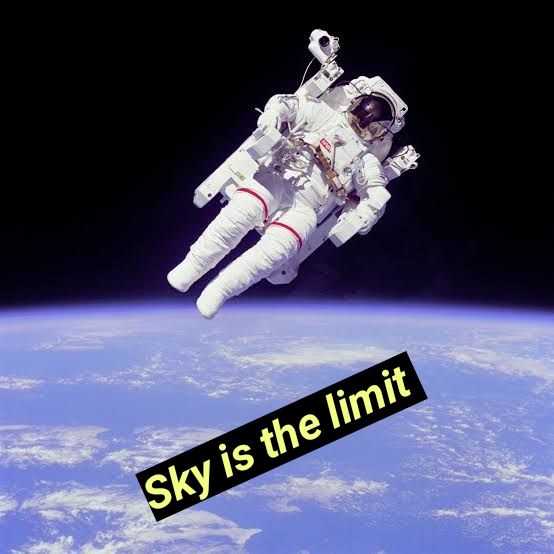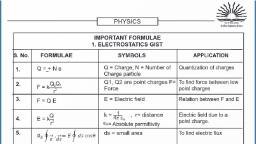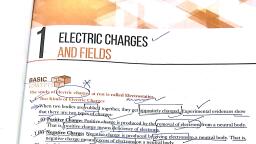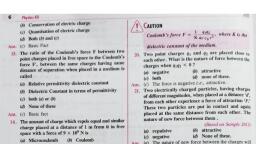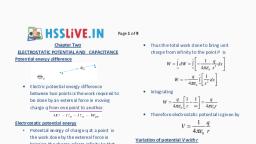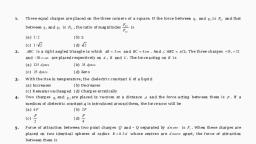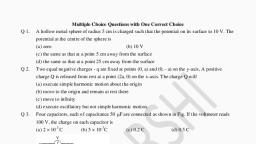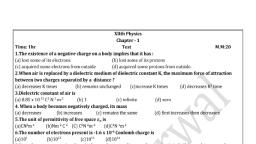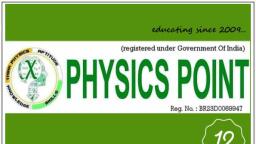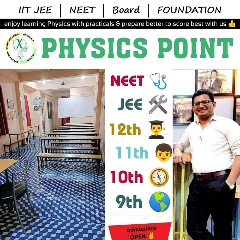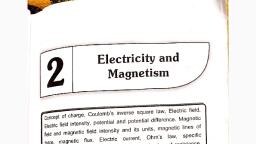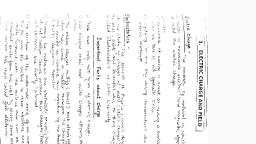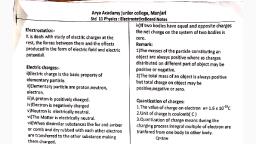Page 2 :
SMT ACADEMY, , PAPAREDDYPALYA CIRCLE, NAGARABHAVI II STAGE, BANGALORE - 72, , TOPIC: ELECTRIC CHARGES AND FIELDS, , , , ELECTRIC CHARGE, , , , a) Charge is quantized. i.e., a charge ‘q’ can take only discrete values such as + e, + 2e, + 3e........, * Imgeneralq=tne (n= 1,2,3.......... J, , Where ‘e’ is known as fundamental or elementary charge and e = 1.6 x 10-1°C, , MULTIPL!, , , , 1) The number of electrons in 1.6 C charge will be, (a) 10°° (b)107° (c) 1.1 x 101° (d) 1.1 x 107°, , , , 16, Ans: (a) Number of electrons, n = 4. —; = 10°, e 1.6x10-19, , 2) When 10" electrons are removed from a neutral metal plate, the electric charge on itis, , (a)-1.6C (b)+1.6€ (c)10#29C (d)10-19C, Ans: (b) Charge, q = ne > Q= 10" x 1.6 x 107? = +1.6C, , 3) Aconductor has 14.4 x 107'*coulombs positive charge. The conductor has (Charge on electron, is 1.6 x 10-1°coulombs), (a)9 electrons in excess (b)27 electrons in short, , (c)27 electrons in excess (d)9 electrons in short, , Ans: (d) Positive charge shows the deficiency of electrons., , 14.4x1077°, Number of electrons, n = a, , 1.6x10-29, , COULOMB’S LAW, , , , (a} Force of attraction or repulsion between two point charges separated by a distance in air /, , vacuum is F = _ 2182. Where €q = 8.854 x 10-1? F/m and — = k = 9 x 10° Units, Meg 4ney, , , , 5 KARNATAKA CET MATERIAL 2020 - 21, , , , , , , , Scanned with CamScanner
Page 3 :
MULTIPL TIONS WITH S', , , , 1) Two charges each equal to 2y1C are 0.5m apart. If both of them exist inside vacuum, then the force, between them is, (a)1.89 N (b)2.44.N (c)0.144.N (d)3.144.N, , 9 (2x10~8)?, , : =k ws =, Ans: (c) Force, F =k G => F=9x 10”. ost = 0.144N, , , , 2) The force between two charges 0.06m apart is 5N. If each charge is moved towards the other by, 0.01m, then the force between them will become, (a)7.20N (b)11.25 N ()22.5N (d)45N, , : 148. ("V5 - (2%) op =, Ans: (b) Force, Fo >= = (2) > 3 = (4) =F, =11.25N, , 3) Two charges of equal magnitudes and at a distance ‘r’ exert a force ‘F’ on each other. If the charges, are halved and distance between them is doubled, then the new force acting on each charge is, (a)F /8 (b)F /4 (c)4F (d)F / 16, , Ans: (d) Force, F =k x, If Qis halved and r is doubled then F = = [Fi], , 4) Two point charges +3y1C and +8uC repel each other with a force of 40N. If a charge of —5yC is, added to each of them, then the force between them wilt become, (a)—10N (b)10N (c)20N (d) —20N, , Ans: (a) In second case, charges will be —2yC and 3yC, , , , 7, F_ QQ, Since F « QiQ2 ie. G = Gite, " 40)... 3x8 _ — Wessin 3 ;, “pan 4 = F’ = —10N (Attractive), , (b) Force of attraction or repulsion between two point charges separated by a distance in, , , , medium of dielectric constant K is F,, = = x me 7 z[F aur], ‘0!, , Where K = dielectric constant of the medium, > K=1 for air /vacuum; K > 1 for insulating material; K = © for metals, , * If any metal of any thickness is placed between the point charges; then force, , between them becomes zero since K = co for metals., , 2 KARNATAKA CET MATERIAL 2020 - 21, , , , , , , , Scanned with CamScanner
Page 4 :
MULTIPLE CHOICE QUESTIONS WITH SOLUTIONS, , , , 1) Two charges Q,and Q, are placed in vacuum at a distance ‘d’ and the force acting between them is, ‘F’. If amedium of dielectric constant 4 is introduced around them, the force now will be, (a)4F (b) 2F (c)F/2 (d) F/4, Ans: (d)In the presence of medium force; Fy, = zlF vacuun] = zIF], , 2) Two charges are at a distance ‘d’ apart. If a copper plate of thickness d/2 is placed between them,, the effective force will be, (a)2F (b)F /2 (co (d) V2F, Ans: (c) Effective air separation between them becomes infinite [K = 0 for metals] so force, , becomes zero., , 3) Two charges placed in air repel each other by a force of 10-*N. When oil is introduced between, the charges, the force becomes 2.5 x 10-5N. The dielectric constant of oil is, , (a)2.5 (b)0.25 (c)2.0 (d)4.0, Ans: (d) By using K = = = K =, , (c) If a dielectric medium (dielectric constant K, thickness t) is partially filled between the, charges; Force of attraction or repulsion between two point charges is, ce 2 Qi1Q2, 4meq [r—t+tVK]”, Example: The force of repulsion between two identical charges when kept with a separation ‘r’ in, air is ‘F’. Half the gap between the two charges is filled by a dielectric slab of dielectric constant =, 4. Then the new force of repulsion between those two charges becomes, , (a) F/3 (b) F/2 (c) F/4 (d) 4F/9, Ans: Without dielectric consant; F; =k Se = k =, , Q@, , With dielectric consant; F, = k —&e __,, , Q, =k—— =k, [r-t+ tvk] [r-t+ tvk]" [r-Z+ Nal’, , se o* 2] te, Fo=kpre=3 [k =| = 7 bo=, , Permittivity of medium, Permittivity of free space, , } KARNATAKA CET MATERL, , (d) Dielectric constant; K =, , , , , , , , , , , , , , Scanned with CamScanner
Page 5 :
Example: Dielectric constant of pure water is 81. Its permittivity will be, , (a)7.12 x 10-1° MKS units (b) 8.86 x 10-'?MKS units, , (c)1.02 x 1043 MKS units (d)Cannot be calculated, Ans: (a) Wehave = Key = 81 x 8.854 x 107? = 7.17 x 10-2 MKS units, , (e) Two point charges placed at a certain distance ‘r,' in air exert a force ‘F’ on each other. Then, , the distance ‘r,,’ at which these charges will exect the same force in a medium of dielectric, , constant ‘K’ is given by ry, = z, , Example: Two point charges placed at a certain distance ’10 cm’ in air exert a force ‘F’ on each other., Then the distance r' at which these charges will exert the same force in a medium of dielectric, constant ‘4’ is given by, (a) 10 cm (b)15 cm (c)5cm (d) 0.5 cm, i ap e ee S, Ans: (c) Distance; r’ = Kan Scm, (If a given charge is divided into two parts which are then kept at some distance apart; the, condition for the force to be maximum / minimum is x =0., Example: A charge Q is divided into two parts of q and [Q — q]. If the coulomb repulsion between them, when they are separated is to be maximum, the ratio of & should be, (a)2 (b)1/2 (c)4 (d)1s4, , Ans: (a) Let separation between two parts be r > F =k sn = ~[aQ —q’], , dE a _ kino ws, For force to be maximum 5 =0> ‘rr [Q-2q] =0, , Q-2q=0, , a), q, , (g) Twocharges Q,; and Q,are at a distance ‘x’ apart. Suppose q is placed at a distance ‘x;’ from, , Q,, then for equilibrium net force on it must be zero, , , , ie. |F1| = |F2| Q Fo @ Fi Q, Which gives x, =~ 11 2, 247 x —_5, , , , Qa, , Example: Two point charges +9e and +e are at 16 cm away from each other. Where should another, charge q be placed between them so that the system remains in equilibrium, , (a)24 cm from +9e (b)12 cm from+9e (c)24 cm from +e (d)12cm from +e, , 4 KARNATAKA CET MATERIAL 2020 - 21, , , , , , , , , , Scanned with CamScanner
